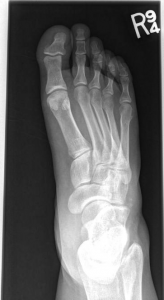This week’s Weekly Report comes to us from Dr. Davlantes.
30 F with a history of obesity and obstructive sleep apnea presents with bilateral foot pain after losing her balance. She was trying to step over her child who was crawling around on the ground, and twisted her feet when she “landed funny.” She is now unable to bear weight on either foot. Here are her x-rays:
What do you see?
The foot has a 2nd metatarsal fracture. This is an easy sell as to why the patient is having trouble walking on that foot. But what else is going on in this XR? The space between the first and second ray of the foot (medial cuneiform + 1st metatarsal and middle cuneiform +2nd metatarsal) is widened. You can especially see this when compared to the normal R foot x-ray. This indicates a Lisfranc injury.
The Lisfranc ligament attaches the medial cuneiform to the base of the 2nd metatarsal. This ligament is often injured by an axial load on the foot combined with twisting. Common mechanisms include sporting activities, falls or impact over a dorsiflexed foot. It is also possible with low-energy falls as described in this case, especially with twisting.The radiographic finding is subtle, with x-ray often read as normal or only showing a slight increase in the distance between the medial and middle cuneiform. It may help to compare x-ray of both feet and obtain weight bearing films to better assess this distance. CT or MRI maybe be obtained if x-rays are nondiagnostic but clinical suspicion remains high. If missed, this injury results in severe foot instability and lifelong arthritis. Treatment is typically surgical repair, though some are managed with casting.
If your patient is unable to bear weight on a foot even if x-rays are read as normal, have a high suspicion for Lisfranc injury! Other clinical signs include ecchymosis to the sole of the foot, or foot swelling out of proportion to injuries seen on radiographs.


